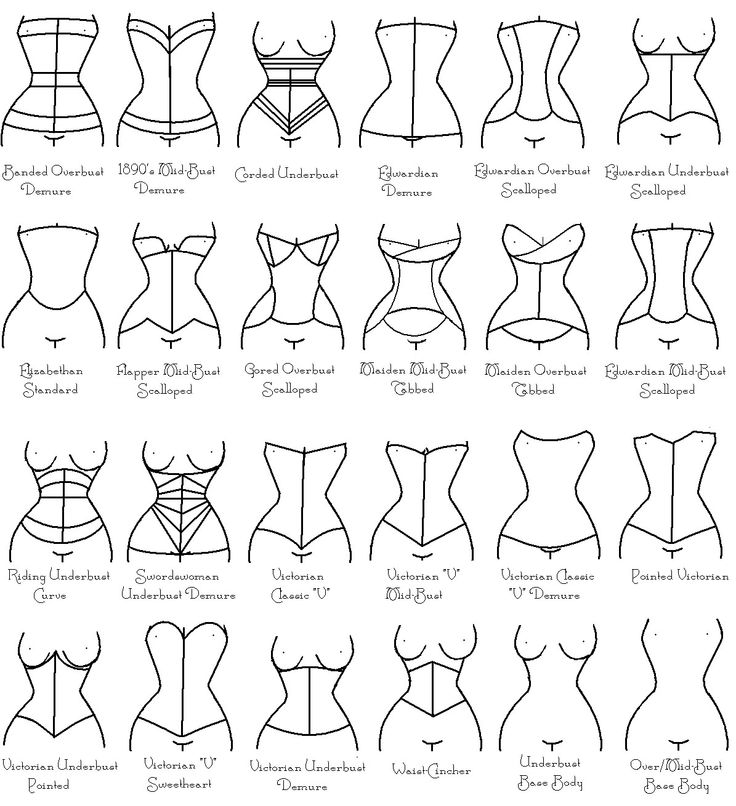Corsetry
Bodice
A bodice is an article of clothing for women, covering the body from the neck to the waist.
The term comes from pair of bodies (because the garment was originally made in two pieces that fastened together, frequently by lacing).
In common usage, bodice refers to an upper garment that has removable sleeves or no sleeves, often low-cut, worn in Europe from the sixteenth century to the eighteenth century, either over a corset or in lieu of one. To achieve a fashionable shape and support the bust, the bodice was frequently stiffened with bents (a type of reed), or whalebone. Bodices survive into modern times in the traditional or revived folk dress of many European countries (see, for example, the Aboyne dress worn by Scottish highland dancers).
Bodice continues in use to refer to the upper portion of a one- or two-piece dress to distinguish it from the skirt and sleeves. The bodice of a dress was called the corsage in the nineteenth century).
Bodices are commonly seen today at SCA events or a Renaissance Fair.
Bondage corsets
Bondage corsets, as used for BDSM, are full-figured corsets that are sometimes called a discipline corsets.
See also Bondage corset
Girdles
The word girdle originally meant a belt (or metaphorically speaking, something which confines or encloses, as in Tolkien's Girdle of Melian). In modern English the term "girdle" is most commonly used for a form of women's underwear that replaced the corset in popularity.
Youths boxing in a Minoan fresco on the Greek island of Santorini. Historically and in anthropology, the girdle can be a scanty belt-shaped textile for men and/or women, worn on its own, not holding a larger garment in place, and even less revealing than the loin-cloth, as was used by Minoan pugilists.
Constructed of elasticized fabric and sometimes fastened with hook and eye closures, the modern girdle is designed to shape and smooth a woman's figure, thereby producing a more aesthetically pleasing and attractive silhouette. Most girdles extend from the waist to the thighs. Older girdles were simply sheaths of fabric that did not cover the crotch.
In the 1960's, these models fell from favor and were to a great extent replaced by the panty girdle. The panty girdle resembles a tight pair of athletic shorts.
Both models of girdles usually include garters to hold up stockings.
Girdles were considered essential garments by many women from approximately 1910 to the late 1960's. They created a rigid, controlled figure that was seen as eminently respectable and modest. They were also crucial to the couturier Christian Dior's 1947 New Look, which featured a voluminous skirts and a narrow, nipped-in waistline, also known as a wasp waist.
A girdle can also garter belt. Later in the 1960's, the panty girdle was generally supplanted by pantyhose. Pantyhose replace girdles for many women who had used the girdle essentially as a means of holding up sheer nylon stockings. Those who want more control purchase "control top" pantyhose. Many women forswear girdles, stockings, and pantyhose entirely.
Girdles and "body shapers" are still sold to women who want to shape their figure with a garment. Some of these garments incorporate a brassiere and thus become functionally equivalent to a corset. However, they do not incorporate boning and hence do not produce the constricted waistline characteristic of Victorian-era corsets.
Hourglass corset
Hourglass corset is a generic term for corsets that produce a silhouette resembling the hourglass shape: wide bottom, narrow waist ("wasp waist"), wide top.
With a modern hourglass corset, the stomach is over the waist. With a Victorian hourglass corset, the stomach is in the waistline.
Tightlacing (also called corset training and waist training)
- Tightlacing is the practice of wearing a tightly-laced corset to achieve extreme modifications to the figure and posture and experience the sensations of a very tight corset. Those who practice tightlacing are called tightlacers. Some tightlacers call the corsets they wear training corsets.
Waist cincher
A waist cincher (waist cinch, waist nipper or waspie) is a short corset that only covers the waist and midriff, so it reduces the waist without covering the chest. They typically have the same construction as a full size corset, as opposed to a corset belt or waspie belt that is constructed as a wide belt. The term waspie comes from the idea that it gives the wearer a wasp waist.
Main article and index is at Corset |
| Articles related to Corsetry |
|---|
|
See also Stockings
Chat rooms • What links here • Copyright info • Contact information • Category:Root

